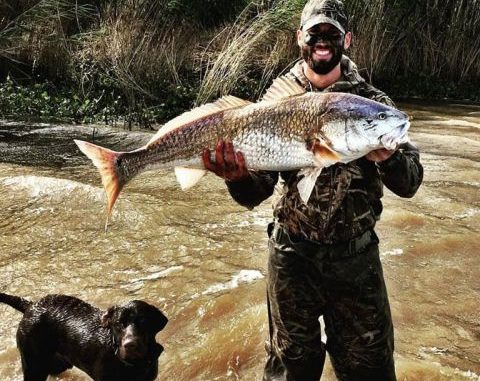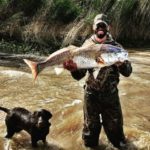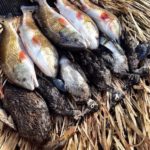
No ducks? Then try for a limit of redfish, instead
For Ben Givens, weekends during duck season are action-packed events at his camp near Wax Lake in the Atchafalaya Delta.
He and his buddies are diehard public lands duck hunters, and tell me stories of their adventures regularly in the gym.
A recent trip was one Givens will likely never forget.
He and buddy Jon Cunningham woke at 3 a.m., rounded up their hunting dogs and gear, then took their boat down toward the Gulf in an area they call “The Delta.” But as fate would have it, another group of hunters was already in their spot.
So it was on to Plan B, only to have another group set up 60 yards away at first light.
They were then forced into Plan C: Checking out some potholes off the Atchafalaya River to try to knock down a few birds and salvage what was left of a hard fought morning.
But first, Givens did what he often does: He cast out his fishing line in the muddy river with a weight and two circle hooks hidden in bait shrimp.
Birds were spooky that morning, and any duck on the brink of shotgun range was flared off by a loud-mouthed chocolate lab. (This was the first time I had ever heard of him not getting a limit, much less a single duck.)
But the frustrating morning would soon take a turn for the better.
While he was walking to the anchored boat in waist-deep water with decoys on his back, he noticed his pole was bent over, and ran to the boat to find there was hardly any line left on his reel.
Cunningham was busy scouting another area, so Givens walked out as far as he could in his waders to gain some line before setting the hook. His reel was spooled only with weak 10-pound Spectra braid.
At first, he thought it was a shark — they often catch sand sharks and blacktips in those waters. Sometimes he’ll catch an occasional flounder or a big black drum, but usually they catch redfish.
This fish, though, seemed a little too big to be a red.
He walked nearly a mile up and down the bank battling the presumed shark, when a gear stripped on his reel. Line was free-spooling as it would on a burnt-out Zebco, but Givens somehow managed to hold it together and continued the fight.
It wasn’t until 30 minutes into the battle – with the fish finally near the shallows – that he saw the telltale spot of a bull red — and the biggest bull he had ever hooked, at that.
Adding to his issues that morning was his dog, which kept swimming around the battling fish, nearly popping the line with its collar.
The big fish finally made it to a 1-foot deep sand shelf, but was still 35 yards from shore, with Givens 25 yards away from the red.
With no net, trying to tug the fish up the long, shallow flat ended up being a mistake — the leader snapped.
The fish flopped and spun around, then started heading back toward the river. So with more than half an hour invested, Givens would be denied a crazy fish tale of a lifetime.
Or would he make it even better?
He instinctively took off in a sprint and dove head first into the murky sand shelf just as the red was about to reach deeper water.
Being soaked from head to toe, with sand in his teeth and fish slime in his beard, wasn’t a concern. The only thing that mattered was getting that trophy bull red in his arms—and he actually succeeded. Lifting weights all year paid off when the giant fish needed to be tackled, bear-hugged and then wrestled out of the water.
Not wanting to injure the specimen — but needing a picture to document his story — Givens held the fish in the water for about 20 minutes until Cunningham got there to document and measure the 42-inch beast.
After releasing the bull, he caught a few more smaller reds for supper and duck hunted that evening, still cold and soaked to the bone in his wet waders.
But also happy as could be after landing his largest-ever redfish in the most unbelievable way.
That day the water was muddy, and the duck hunters/fishermen usually prefer using dead shrimp or crabs on the bottom to catch reds in those conditions.
When the water is cleaner, or hardheads or sailcats are too numerous, they’ll use a popping cork and a purple-and-chartreuse Vudu shrimp to sight-fish reds in the shallows. No matter if they are using the large outboard or the Gator-Tail, they’ll wade-fish and catch under just about any tidal condition.
Fishing between morning and evening duck hunts keeps the day action-packed, but it’s not just saltwater fish they target. When hunting further upriver in the freshwater of the Wax Lake area, they also catch catfish, bass or perch during the day, and sometimes set trot or jug lines with duck parts after cleaning the day’s hunt.
After the evening duck hunt, they run catfish lines or go frogging if it’s warm enough. For more challenging experiences and a workout, they battle the current from kayaks to duck hunt and fish.
I didn’t ask, but at the camp they apparently don’t do much sleeping at all.
Sometimes a limit of ducks is downed quickly, and sometimes you don’t even see a bird. But either way, be sure to bring a rod and some bait along with the decoys and guns.
A great day of hunting — and maybe your biggest bull red ever — might just happen during the same trip.




